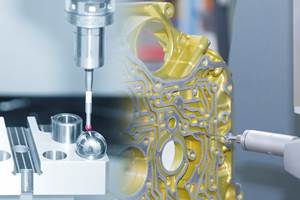The 'Issues' With Height Gages
Don't tell anyone, but there is something of a problem with height gages. The big issue that they have is what they measure: height.
Share





Don't tell anyone, but there is something of a problem with height gages. The big issue that they have is what they measure: height. The larger the height gage, the bigger the potential problem.
It's not actually the height that is the problem. It's the relationship of a large height to the small base. Just like for a lever—the longer the arm, the larger the multiplying factor—for a height gage this is a problem. I am not only talking about the errors coming from the gage itself, but also the errors in the setup. These get magnified and can potentially distort an otherwise carefully planned comparison.
A major error in the design of a basic height gage is taking a design that was meant to measure 12 inches and simply extending the post to measure 36 inches without changing the base design or the cross area of the measuring post. What then happens is that the gage will tend to wobble and flex. Although you may not be able to see the 0.001-inch wobble, it can become a significant part of the part tolerance and can certainly influence measurement.
A normal step in trying to increase the performance of the gage is to beef up the column in an attempt to reduce the flexure of the post. However, this only gets us part of the way to a better gage. For example, if slight pressure is placed horizontally against the gage's measuring contact, the gage may slide along the table. If the same force is applied to the measuring contact when it is near its maximum upper position, this force will likely cause the gage to tip over. What you need to do is to make the base longer and wider and build in some mass. By decreasing the ratio of the post to the base, there will be significant improvement in its performance.
In addition to its own personal issues, the height gage tends to keep company with tools that have bad references. Most height gages are used with a surface plate. The surface plate provides the reference for the part and the height gage. Many surface plates are clean and well maintained. But there are those that may not be as clean as they look. A small metal chip or even a hair, while almost impossible to see, could throw off the measurement by 0.020 inch at a height of only 10 inches.
Next to dirt, the actual surface of the granite surface plate plays a key role in the performance of the gage. Any slight imperfection between where the part and the gage are staged will be amplified the higher the measurement. Most surface plates have a flatness spec of 50 microinches. If the base is 6 inches long, a 50-microinch error would grow to more than 0.0003 inch in 36 inches.
As a concerned parent to your height gage, it's up to you to deal with its issues and choose who will be working with it. Look at the height gage to make sure it is beefed up for the job, and check to make sure it has a precision surface to rest on.
Related Content
Rethink Quality Control to Increase Productivity, Decrease Scrap
Verifying parts is essential to documenting quality, and there are a few best practices that can make the quality control process more efficient.
Read MoreHow to Choose the Correct Fixed-Body Plug Gaging Solution
The two types of fixed-body plug gages are both accurate, fast and easy to use. Consider these factors when selecting one for your gaging application.
Read MoreProcess Control — Leveraging Machine Shop Connectivity in Real Time
Renishaw Central, the company’s new end-to-end process control software, offers a new methodology for producing families of parts through actionable data.
Read MoreThe Link Between CNC Process Control and Powertrain Warranties
Ever since inventing the touch-trigger probe in 1972, Sir David McMurtry and his company Renishaw have been focused on achieving process control over its own manufacturing operations. That journey has had sweeping consequences for manufacturing at large.
Read MoreRead Next
Machine Shop MBA
Making Chips and 91ÊÓƵÍøÕ¾ÎÛ are teaming up for a new podcast series called Machine Shop MBA—designed to help manufacturers measure their success against the industry’s best. Through the lens of the Top Shops benchmarking program, the series explores the KPIs that set high-performing shops apart, from machine utilization and first-pass yield to employee engagement and revenue per employee.
Read MoreAMRs Are Moving Into Manufacturing: 4 Considerations for Implementation
AMRs can provide a flexible, easy-to-use automation platform so long as manufacturers choose a suitable task and prepare their facilities.
Read More


















